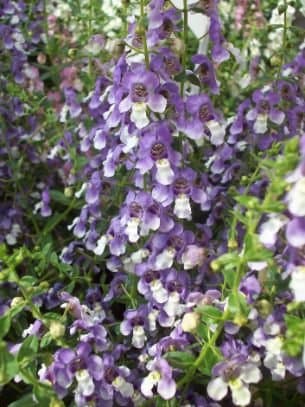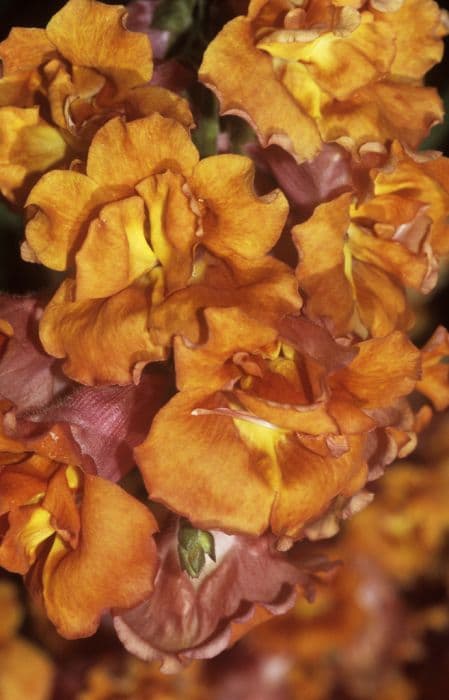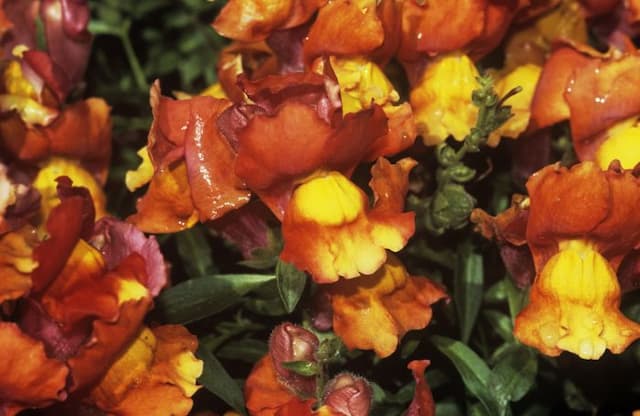Purple Bell Vine Rhodochiton atrosanguineus

ABOUT
The plant commonly referred to as the Purple Bell Vine is notable for its captivating and ornamental appearance. It produces charming, bell-shaped flowers that have a deep, purple to almost black hue, with an interior that is often a lighter pink to magenta coloration, which provides a stunning contrast. These delicate-looking flowers dangle elegantly from thin, wiry stems that allow them to sway gracefully with any passing breeze. Sporting heart-shaped leaves, the foliage of the Purple Bell Vine has a lush, green appearance that serves as an attractive backdrop to the striking flowers. The leaves cling to supporting structures, as this plant exhibits climbing or trailing growth habits, and will often twine around anything they can grasp, making it ideal for trellises or as a spill-over plant in hanging baskets. Overall, the distinctive look of the Purple Bell Vine with its contrasting flower colors and heart-shaped leaves creates a visually appealing display, making it a favored choice for gardeners looking to add a touch of drama and vertical interest to their outdoor spaces.
About this plant
 Names
NamesFamily
Plantaginaceae
Synonyms
Purple Bell Vine, Mexican Creeper, Chinese Purple Bell, Bell Vine
Common names
Rhodochiton volubile, Asarina atrosanguinea, Lophospermum atrosanguineum
 Toxicity
ToxicityTo humans
The Rhodochiton atrosanguineus, commonly known as the purple bell vine, is not widely reported to be toxic to humans. However, like with many plants, it is generally advisable to avoid ingesting it as it is not a food crop, and its effects when ingested are not well-documented. There are no widely known or reported symptoms of poisoning for this plant in humans, but as a precaution, it is best to keep it out of reach of children who might accidentally ingest it. If ingestion does occur, it is recommended to seek medical advice.
To pets
The purple bell vine is not specifically listed as toxic to pets, but since comprehensive studies may not have been conducted for all plant species, caution is still recommended. If a pet ingests this plant and shows signs of illness, such as vomiting, diarrhea, or unusual behavior, it is important to contact a veterinarian. While the exact symptoms of poisoning from the purple bell vine in pets are not well-established, it is always better to prevent pets from eating ornamental plants.
 Characteristics
CharacteristicsLife cycle
Perennials
Foliage type
Deciduous
Color of leaves
Green
Flower color
Purple
Height
10 feet (3 meters)
Spread
3 feet (1 meter)
Plant type
Climber
Hardiness zones
9
Native area
Mexico
Benefits
 General Benefits
General Benefits- Aesthetic Value - Adds visual interest to gardens with its unique bell-shaped, deep purple flowers and ornamental foliage.
- Habitat for Wildlife - Attracts pollinators like hummingbirds and bees, supporting the local ecosystem.
- Low Maintenance - Tolerant of neglect and does not require frequent watering or intensive care once established.
- Shade Tolerant - Capable of growing in partially shaded areas, providing versatility in garden design.
- Versatile Usage - Suitable for hanging baskets, trellises, and vertical gardening, providing multiple landscaping options.
- Fast Growing - Quickly covers structures or spaces, providing a lush appearance in a relatively short period of time.
- Long Blooming Period - Produces flowers from early summer to fall, offering prolonged enjoyment throughout the growing season.
 Medical Properties
Medical PropertiesThis plant is not used for medical purposes.
 Air-purifying Qualities
Air-purifying QualitiesThis plant is not specifically known for air purifying qualities.
 Other Uses
Other Uses- Rhodochiton atrosanguineus, commonly known as the purple bell vine, can be used in educational settings for botany or horticulture students to learn about unique flowering plant structures and pollination mechanisms due to its distinctive bell-shaped flowers.
- The dangling flowers of the purple bell vine make a visually appealing subject for botanical illustrators and artists who specialize in capturing the beauty of plant life.
- As a fast-growing vine, Rhodochiton atrosanguineus can be utilized in theater productions or film sets as part of the scenery to convey a lush or exotic setting quickly.
- With its decorative qualities, the purple bell vine can be used in crafting, such as making wreaths or other floral arrangements for events and festivals.
- Due to its vigorous growth habit, Rhodochiton atrosanguineus can be trained to grow over unsightly structures, such as chain-link fences, providing a natural screen and improving the aesthetics of urban environments.
- The plant's stems and flowers can be used in creating natural dyes, with the potential for hobbyists or artists to explore the variety of colors produced by different parts of the plant.
- The purple bell vine can be a living curtain for outdoor gazebos or patios, providing a mix of shade and colors when grown on a trellis or pergola.
- Its intriguing flowers can be inspirational to jewelry designers, who might mimic the shape and color of the blooms in their designs.
- Hobby photographers can use the unique appearance of Rhodochiton atrosanguineus to practice macro photography and depth of field techniques due to the depth and detail within the bell-shaped flowers.
- Beekeepers sometimes plant Rhodochiton atrosanguineus in or near their apiaries as its flowers are attractive to bees, potentially supporting the health and productivity of the bee colonies.
Interesting Facts
 Feng Shui
Feng ShuiThe Purple Bell Vine is not used in Feng Shui practice.
 Zodiac Sign Compitability
Zodiac Sign CompitabilityThe Purple Bell Vine is not used in astrology practice.
 Plant Symbolism
Plant Symbolism- Elegance: Rhodochiton atrosanguineus, commonly known as the Purple Bell Vine, is known for its graceful hanging stems and bell-shaped flowers, embodying an air of elegance and sophistication.
- Mystery: The deep purple to almost black color of the flowers can be symbolic of mystery or the unknown, intriguing the onlooker with its unique hue.
- Attraction: With its attractive and distinctive appearance, the Purple Bell Vine is often associated with allure and the power to captivate one's attention.
 Water
WaterThe Purple Bell Vine should be watered when the top inch of soil feels dry to the touch, which typically means once a week. During the active growing season in spring and summer, it may require more frequent watering, possibly twice a week. It's crucial to provide thorough watering, allowing water to run through the drainage holes, ensuring that the soil is moistened evenly. Depending on the pot size and environmental conditions, this might mean approximately 16-24 ounces of water each time. In winter, reduce watering to every couple of weeks or when the soil is dry several inches down, as the plant's water needs decrease during dormancy.
 Light
LightPurple Bell Vine thrives in bright, indirect sunlight, making an east or west-facing window ideal for providing the light it needs without the harsh intensity of direct midday sun. Avoid placing it in the full afternoon sun as it can cause leaf scorch, preferring a spot that offers soft filtered light for several hours a day.
 Temperature
TemperaturePreferably, the Purple Bell Vine should be kept in temperatures ranging between 50°F and 75°F, avoiding sudden temperature swings. They can withstand a minimum temperature of approximately 40°F but shouldn't be exposed to frost, as it can be damaging. The ideal temperature range promotes healthy growth and flowering throughout the growing season.
 Pruning
PruningPruning Purple Bell Vine is primarily done to encourage bushier growth and to maintain a desirable shape. Trim the plant lightly as needed, removing any dead or yellowing leaves to promote new foliage. The best time to prune more heavily is in early spring before new growth begins. This can be done annually to keep the plant looking its best and to prevent it from becoming too leggy.
 Cleaning
CleaningAs needed
 Soil
SoilThe Purple Bell Vine prefers a well-draining soil mix rich in organic matter, with loam or a peat-based mixture being ideal. A soil pH range of 6.1 to 7.5 is optimal for growth.
 Repotting
RepottingPurple Bell Vine should be repotted every couple of years in spring. It is not overly sensitive to being pot-bound, so frequent repotting is not necessary.
 Humidity & Misting
Humidity & MistingPurple Bell Vine thrives in moderate to high humidity levels, ideally between 50-70%. Avoid placing it in excessively dry environments.
 Suitable locations
Suitable locationsIndoor
Place Purple Bell Vine in bright, indirect light indoors for best growth.
Outdoor
Grow the Purple Bell Vine in partial shade or full sun if not too hot.
Hardiness zone
9-11 USDA
 Life cycle
Life cycleThe life of the Purple Bell Vine (Rhodochiton atrosanguineus) begins with seed germination, which requires warmth and generally takes place in early spring. Following germination, seedlings emerge and develop into young plants with heart-shaped leaves. As the plant matures, it sends out long, twining stems which are characteristic of its growth habit, and these will require support to climb. Throughout the summer months, Purple Bell Vine produces its distinctive bell-shaped flowers, which are deep purple with a blackish tone, usually starting the bloom from mid-summer to fall. After flowering, if pollination occurs, the plant will develop small fruit containing seeds that can be collected for propagation. In colder climates, Rhodochiton atrosanguineus is often grown as an annual, although it is a perennial in its native habitat and can overwinter in milder climates with appropriate protection.
 Propogation
PropogationPropogation time
Spring to early summer
Rhodochiton atrosanguineus, commonly known as Purple Bell Vine, is typically propagated by seed. The optimal time for sowing seeds is in the late winter to early spring, ensuring that the soil is warm enough to aid germination. To propagate by seed, first, soak the seeds in water for a few hours to soften the tough outer shell. Then, plant the seeds at a depth of approximately 1/4 inch (about 6 millimeters) in well-draining soil and lightly cover with more soil. The soil should be kept consistently moist, but not waterlogged, until germination occurs, which generally takes about two to four weeks. Seedlings can then be transplanted outdoors once all threat of frost has passed and temperatures are consistently warm.









